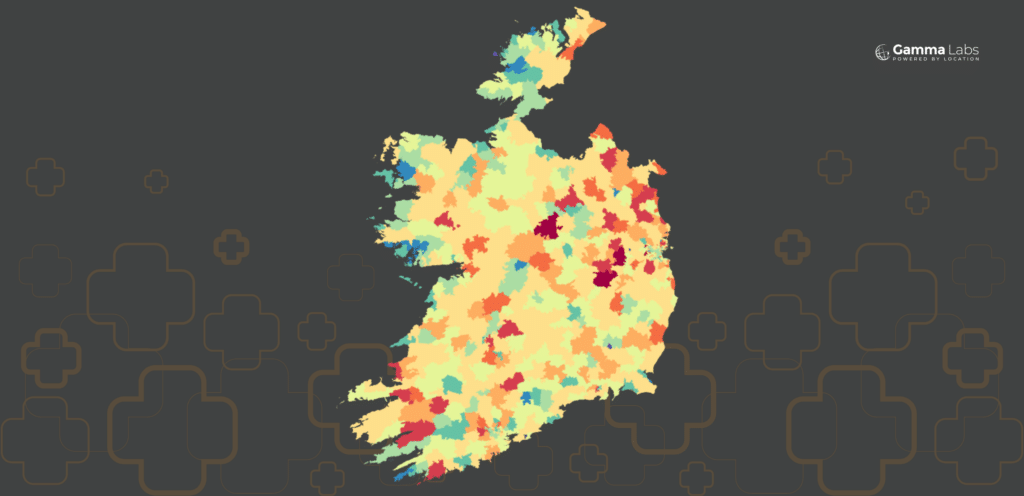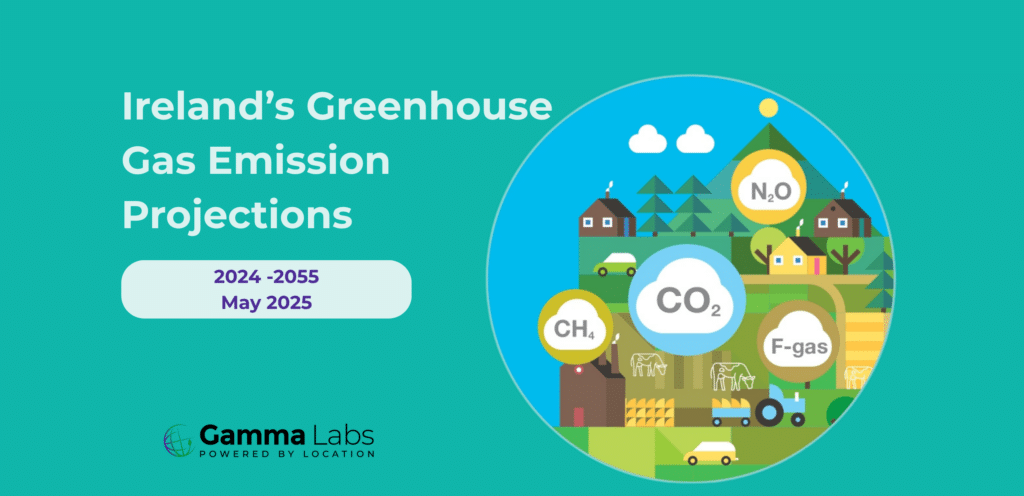Webinar Overview: GeoInsurance Ireland 2021 – Part 1

CLIMATE RISK, REGULATORY CHANGES & NEW DATA:
WHAT’S THE FORECAST FOR IRELAND?
KEY TAKE-AWAYS:
- Ireland can expect increased heatwaves in the summer, as well as flooding from rivers, landslides, bog slides in heavy rain, and increased wildfires and droughts if global trends continue without mitigation.
- A litany of change – environmentally and regulatory – will impact financial services organisations and their day-to-day practices.
- Overwhelming perhaps – but support, guidance and solutions based on your best practice are here – an antidote in a sea of potential chaos.
Shining Light on the Darkness of Climate Change
What’s the forecast for Ireland…?
Four passionate speakers walking delegates through the trials and tribulations that this beautiful emerald isle will potentially face as climate related events persist.
And whilst it was whistle-stop in places – and potentially overwhelming in its predictions – the key message was that the impact of climate change on assessing changing risks and aligning to regulatory pressures is not insurmountable.
Trusted Solutions for Now & Tomorrow
Richard Garry of Gamma opened the session with an overview of the business and reassurance that it is ideally placed to consume and enable clients to use climate change data and insights to make better informed decisions.
Drawing on Gamma’s multi-sector experience, Richard touched on the outcomes of various projects that look to appraise the impact of climate change on organisations that insure and/or manage physical assets – from exposure related to banks mortgage books through property backed loan portfolios, as well appraisal of projected impacts on businesses across Local Authorities, Utilities, Telecoms, Property agencies and Retail.
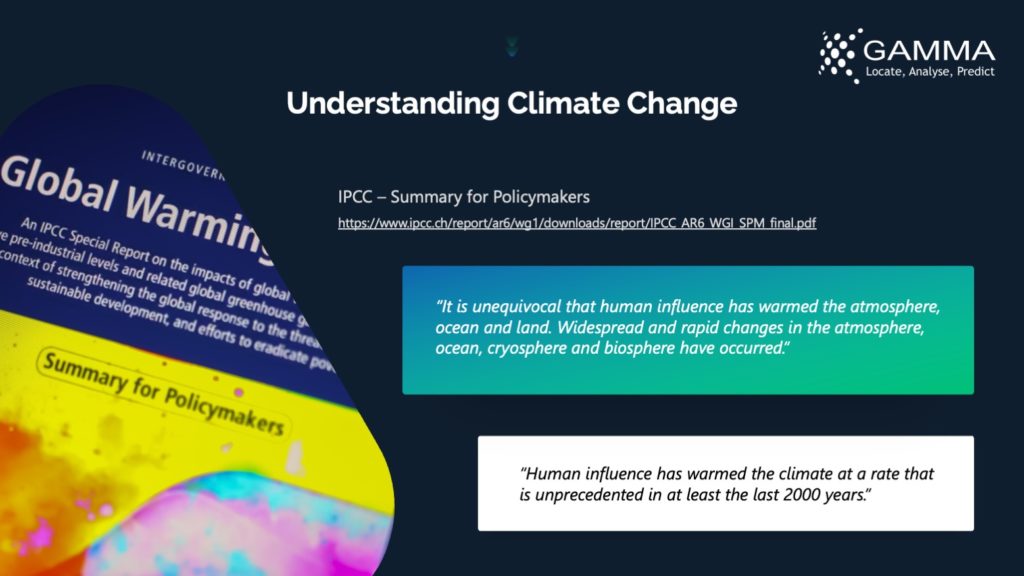
Slide Image 1: The Underlying Truth
Essentially, better enabling any organisation that owns or manages property – and is keen to understand the environmental risks that will impact those properties.
Easily said – but perhaps more challenging – and often overwhelming – for businesses of all shapes and sizes to implement.
Whilst we know that climate change is happening – with extreme weather events happening on a more regular basis – much of the forecasting is future looking – often many, many years ahead – and perhaps feels less immediate, especially if you are writing business today.
How does the catastrophe predicted in 2050, really impact me today and my prospective customer for the next 1, 3, 5, or 10 years…?
But as time continues to move forward there are considerations that we should be making today to limit the risk exposure of climate change, such as:
- Assessing the impact on your existing book of business
- Integrating the impacts into your “business as usual” process to understand (near future) risk at the point of policy inception – streamlining and managing the data in line with your process
- Changes in and drive towards more regulatory reporting with regards to risks impacted by climate change, and
- Impact of climate change on investments (asset risk exposure) – long term investments and the future potential impact prior to investing large amounts of capital into a project or development that may have the potential to be severely impacted by climate change.
Each of these Gamma enables clients to consume during their usual trading processes and procedures – empowering clients to better mitigate risk and make well informed decisions.
But will climate change really have an impact on Ireland…?
Adaptation & Mitigation
From an academic viewpoint – and at the cutting edge of climate change research – Dr James Fitton of MaREI and UCC took the reins to walk through the evidence of climate change and its potential impact on Ireland.
Setting the scene, Dr Fitton covered the fundamentals from where the planet was pre-industrialisation, to observed upward temperature records of the post-industrial era. The evidence is a massive up-tick (comparatively) in global temperatures and extreme weather events over the last 200 years. It is largely undenied that human influence – industrialisation, activities and the burning of fossil fuels – have been the catalyst to rising climates globally for many years.
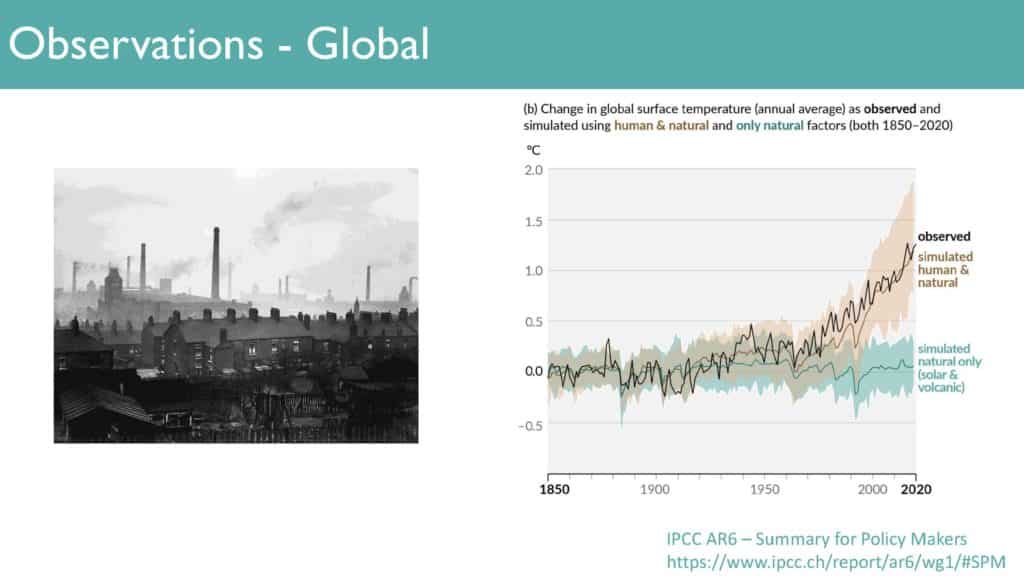
Slide Image 2: The observed and measured view over the last 200 years – change is due to industrialisation and human activity, going beyond the impact of natural processes alone
Ireland is affected in the same way as any other country with warming of almost 1-degree during the post-industrialisation period. That upward trend is predicted to continue in Ireland over the coming years.
It is happening. It will come to pass.
But what does it mean for Ireland…?
Heat waves will be more frequent and more intense – especially for the southern part of Ireland. The level of precipitation will increase. As will river flooding and flash floods. And landslides and bog slides.
Conversely, hydrological and ecological droughts will increase – creating the perfect conditions for wildfires and the increase in their potency and frequency.
Windstorm evidence and projections aren’t as well developed. However, whilst the projection of increased frequency is less clear, there is strong evidence in the projected increase in intensity of windstorm events. Speed is the most destructive element, but the coastal nature of much of Ireland also means that stronger, faster windstorms can cause catastrophic sea surge and coastal erosion damage associated with rises in sea levels.
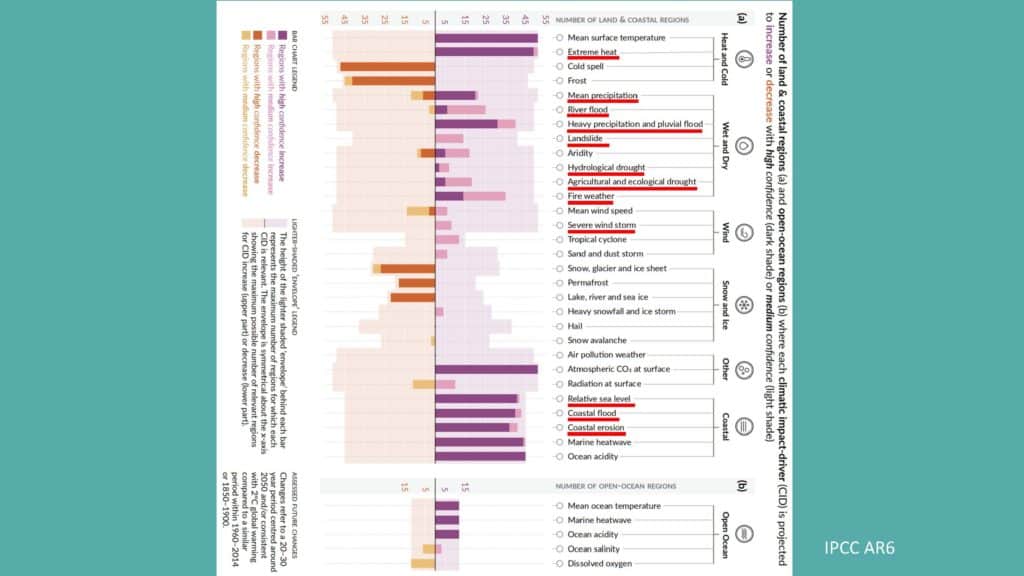
Slide Image 3: Severe risks in context
The long-term view is hard to digest, but the need to change is now.
Agreements and the implementation of proposals at COP26 is a step in the right direction, but still above the target of 1.5-degree change in global warming. So even with planned action, some of the changes will come to pass.
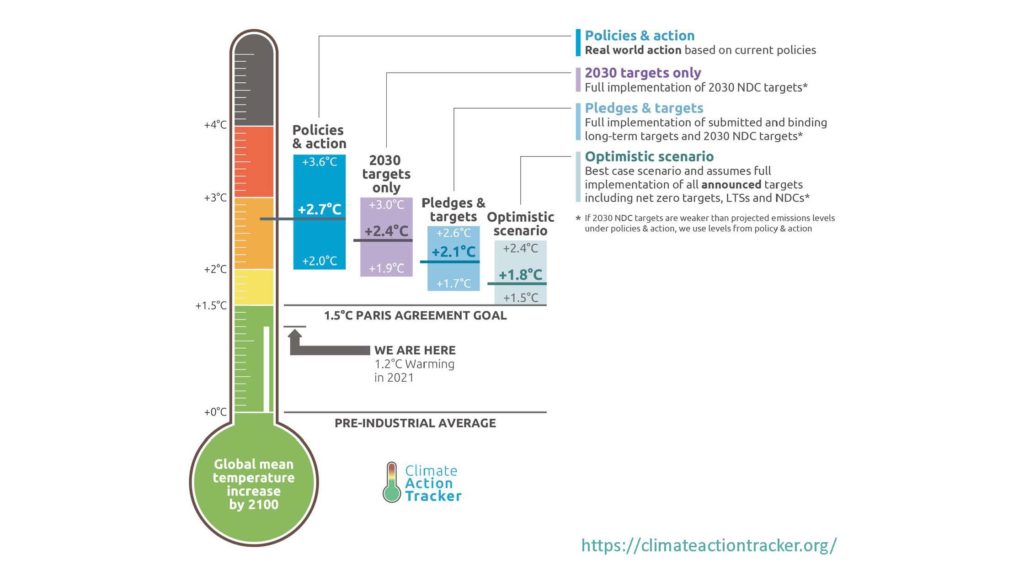
Slide Image 4: Visual summary of COP progress & agreements
As such, the key takeaway is that Adaptation and Mitigation are essential:
- Adaptation to the current and future climate
- Mitigation in terms of reducing our emissions to limit future global temperature rises.
More to do, but we can all play our part.
We need to stop kicking the “climate change can” down the road and start to worry – and make contingencies – for change. Without planning and change, the potential is for economies and businesses to collapse.
It sounds doomsday like, but it’s the trendline sadly.
Helpful Steps in an Evolving Journey
So how do we mitigate and start to implement for the future…?
Richard Cantwell, principal consultant at Gamma, takes a look at the practicalities of the day-to-day use of climate change projections – as an aid to decision making in Ireland today.
Building on the academic theory and projections, Richard took a view on the “day-to-day” impact from an individual property perspective.
Underpinning this section of the webinar – and the project examples illustrated – was one of the standout points from the IPCC report, which stated:
“What is currently a 1-in-100-year extreme sea level (ESL) height…
will be expected once or even multiple times per year in the future at many locations”.
Essentially, what was once rare will become more common place. Validating the point made by Dr Fitton in that it is the increased frequency in events that will be seen in most well researched cases of climate change impacts.
And of course, with more common (frequent) events there lies the potential for more common (frequent) damage to life, property, and the environment we associate with.
A key resource for the professional and casual observer is the Interactive Atlas for Northern Europe which highlights key projected outcomes [LINK]:
- Increase in mean and extreme heat
- Reduction in cold spells
- Mean and heavy precipitation and pluvial flood are set to increase
- Severe windstorms show a moderate confidence in potential increase
- Whilst relative sea-level, coats erosion and coastal flood show a high level of confidence in projected increases.
All of these measures are important and are of collective concern. However, given limited time the primary focus was on the impact of flooding – which is also perhaps the most relatable impact of climate change for many of us.
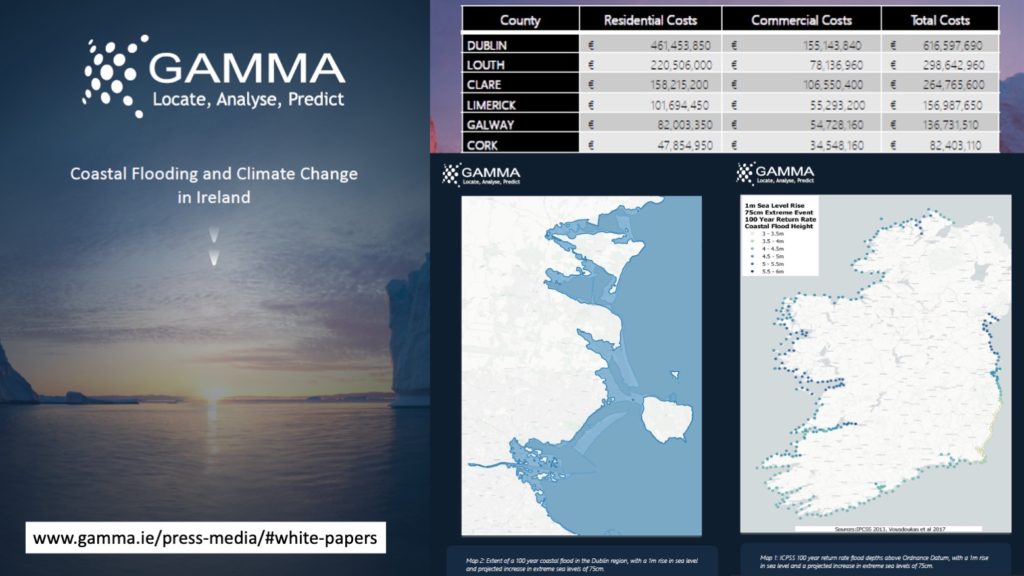
Slide Image 5: The impact of coastal flooding on Ireland
Utilising data from the likes of OSNI, OSI, OS, Geological Survey of Ireland, British Geological Survey, Ambiental, JBA, BlueSky, Metswift, and Terrafirma in combination with Gamma’s own data we were walked through how data that is available today can help address decision making for tomorrow.
Looking at change over time in terms of property flood risk is a key use case for those who own, service and/or manage these assets.

Slide Image 6: Applying broad scenario insights to individual property risk
We looked at storms and wind speeds and the impacts that they have on buildings and the built environment based on proximity to trees and river estuaries. And soil data can provide a view on shrink-swell impacts which are a primary cause of subsidence related issues.
Collating these datasets and delivering them in a meaningful way to clients – whether via a Gamma solution or through APIs – to enhance asset owners understanding of potential risk and to place context within their decision-making processes.
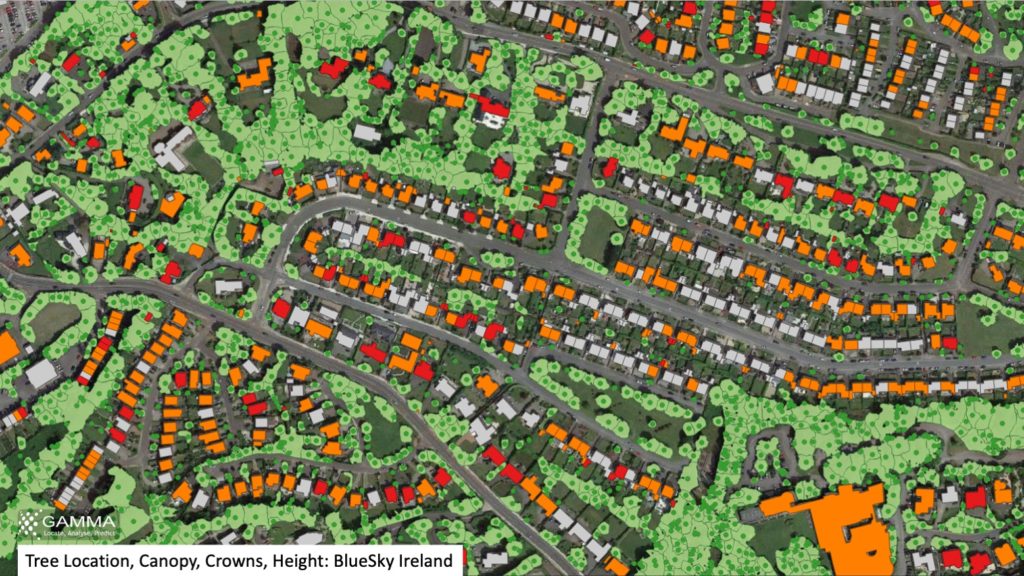
Slide Image 7: Properties at high & severe risk from tree collapse/storm damage in Perilfinder
The Inevitability of Compliance
Alongside the changing nature, quality and coverage of data is the irrepressible force of regulatory change and compliance.
It was left to Johnny Mattimore, of First Derivative, to anchor the session with a whistle-stop tour through climate related regulatory change in the Financial Service market in Ireland.
It’s the convergence of interests amongst Banks, Insurers and Asset Managers leading to common alignment around regulations, standards, and valuations – much of which is driven by the green agenda and accountability relating to limiting the investment in non-climate friendly practices.
It’s widely accepted – and understood – that the greatest threat to economic success, stability, human migration – from asset valuation through to societal problems – comes substantially from climate change or climate risk.
Therefore, the response from most governments has been to look at the viability of de-carbonisation policy. As a result, climate risk is fundamentally restructuring economic theory for the next 30-50 years.
So why has this grabbed the imagination of governments, policy makers and big companies…?
The drive from these various economic bodies has come largely in response to major events – from temperature change to health pandemics – originally led by the UN as early as the 1990’s, large frameworks developed by global bodies during the 2010’s and more recently sectoral and business leaders moving faster than governmental policy requirements in the 2020’s. A trend that seems set to continue.
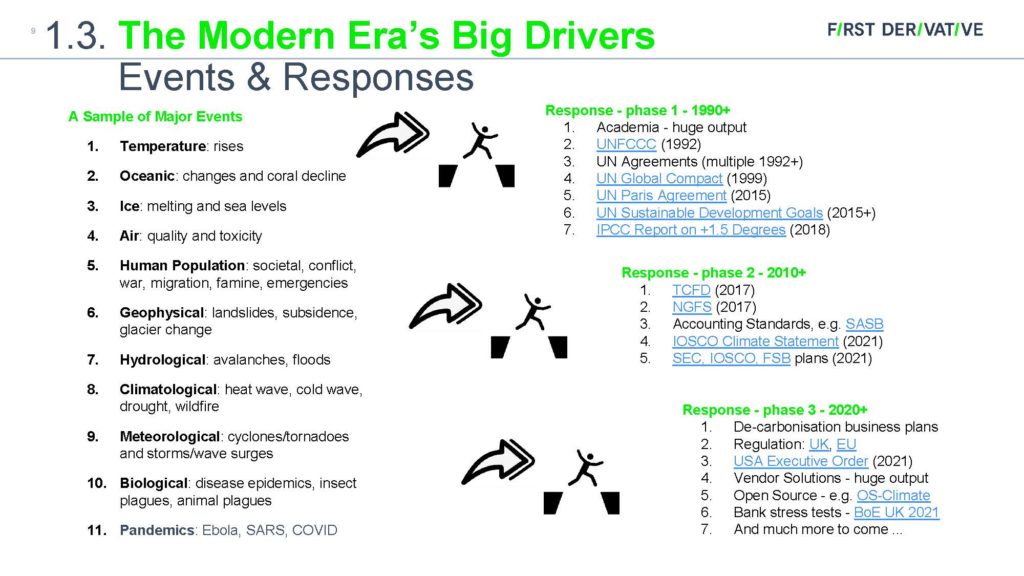
Slide Image 8: Events & risks driving change
It may be controversial, but the urgency of the issue is driving this approach – and whilst we might determine that this is for the greater good, the perceived wisdom is that it’s driven by concern over monetary stability – a selfish concern – the concern over losing money.
The overwhelming challenge for Financial Services businesses is the integration of data and models that will better enable their capability to make decisions and align with regulatory demands.
So, what’s the impact…?
The problem is a familiar one – it’s just that the focus and effort need to be adapted to report on decarbonisation.
As such the real challenge is how we translate long term scenarios into near term evaluations – projections are so far into the future, that whilst we need to act now, the relevance to writing business today is difficult to comprehend.
Carbon rating – similar to credit ratings – will evolve and provide guidance.
Collating the analytics and aligning with regulations will be key.
Data requirements – internal, external, accessibility, structure, reporting and especially its management – will be huge and diverse.
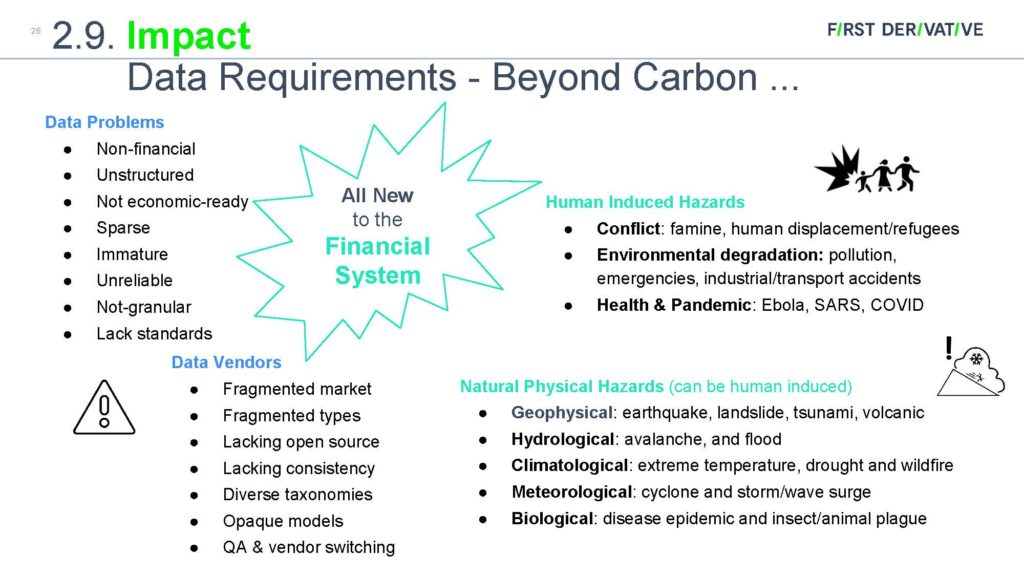
Slide Image 9: The proliferation & diversity of data – support from trusted partners will be crucial (an approach that is central to the solutions that Gamma provides)
The cloud is going to be key in solving this. Financial service providers of all shapes and sizes won’t be able to achieve this in traditional legacy ways – it must be cloud first.
What are the takeaways…?
New regulations, standards, and valuations – it feels like a perfect storm of new requirements needing transformational change for many.
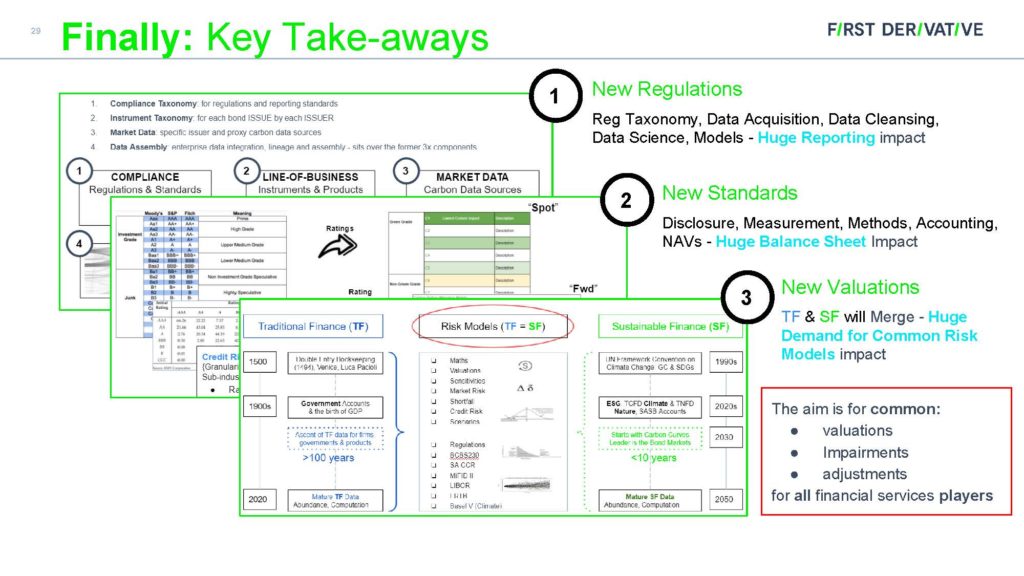
Slide Image 10: Everything will be different… in the future
As overwhelming as this all seems support, experience and viable solutions – that will evolve as business and requirements change – are available today.
Helping organisations like yours embrace the change we see today, in order for you to address the unwritten tomorrow.
@ 2021 Gamma.ie by Jason Day
About Gamma
Gamma is a Location Intelligence (LI) solutions provider that integrates software, data and services to help our clients reduce risk through location intelligence. Established in Dublin, Ireland in 1993, and with offices in Manchester, UK and Bilbao Spain, the company has expanded to become a global provider of cloud-native location intelligent systems and services. Gamma’s Perilfinder™ risk mapping platform provides property underwriters with access to trusted property-level risk data easily, quickly and accurately.
